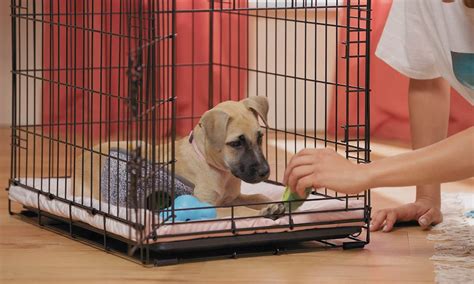Learn how to understand your dog’s behavior, choose the right crate size, and create a positive crate environment. Establish a routine and use positive reinforcement effectively.
Understanding Your Dog’s Behavior
Understanding your dog’s behavior is essential for successful crate training. Dogs have their own unique personalities and habits, and it’s important to recognize and respect these traits when introducing them to a new environment such as a crate. Take the time to observe your dog’s body language, vocalizations, and overall demeanor to better understand their needs and preferences.
It’s also important to consider your dog’s history and past experiences, as these can greatly influence their behavior. A rescue dog, for example, may exhibit different behaviors than a dog that has been raised in the same home since puppyhood. By understanding your dog’s unique background, you can tailor your crate training approach to best suit their individual needs.
Additionally, dogs are highly social animals and thrive on routine and consistency. Understanding how your dog responds to various stimuli and interactions will help you anticipate their behavior when it comes to crate training. By recognizing and respecting your dog’s behavior, you can create a more positive and effective crate training experience for both you and your furry friend.
Choosing the Right Crate Size
When it comes to crate training your dog, one of the most important steps is choosing the right crate size. The crate should be large enough for your dog to stand up, turn around, and lie down comfortably. If the crate is too small, your dog will feel cramped and may not want to spend time in it. On the other hand, if the crate is too big, your dog may feel anxious and insecure. It’s important to measure your dog and choose a crate that provides enough space for them without being too spacious.
Consider the adult size of your dog when selecting a crate. Puppies grow quickly, so it’s important to choose a crate that will accommodate their full-grown size. You can estimate the adult size of your dog based on their breed and the size of their parents. It’s better to choose a crate that is slightly larger than your dog’s current size, as long as you can section off part of the crate to make it smaller and cozier for your puppy.
Keep in mind that the crate should be a comfortable and safe space for your dog. Along with choosing the right size, it’s important to consider the material and design of the crate. Make sure the crate is sturdy, well-ventilated, and provides good visibility for your dog. Additionally, you can add a comfortable bedding, toys, and treats to make the crate a positive and welcoming environment for your dog.
Introducing the Crate Positively
When it comes to crate training your dog, it’s important to start off on the right foot by introducing the crate positively. This means making the crate a place that your dog wants to go into, rather than something they fear or avoid. One way to do this is by using positive reinforcement to associate the crate with good things. You can start by placing treats or toys inside the crate, and encouraging your dog to explore and interact with them.
Another tip for introducing the crate positively is to make sure that your dog has a comfortable and inviting environment inside the crate. This can be achieved by adding a soft blanket or cushion for your dog to lie on, and making sure that the crate is the right size for them. A crate that is too small or cramped can be uncomfortable and lead to negative associations, so it’s important to choose the right crate size for your dog.
It’s also important to be patient and consistent when introducing the crate positively. This means giving your dog time to get used to the crate at their own pace, and being consistent with your approach. If you use the crate as a punishment or force your dog into it, they are unlikely to see it as a positive space. Instead, take your time and use positive reinforcement to create a positive association with the crate.
Establishing a Routine
Establishing a routine is essential for successful crate training of your dog. Dogs thrive on routine, and having a set schedule can help them feel more secure and comfortable in their crate. Try to feed your dog at the same times each day, and take them out for potty breaks on a consistent schedule. This will help them learn when to expect meals and bathroom breaks, making it easier for them to adjust to spending time in their crate.
Additionally, incorporating regular exercise and playtime into your dog’s daily routine can prevent them from feeling bored or restless in their crate. When dogs are adequately exercised, they are more likely to relax and rest quietly in their crate, rather than feeling anxious or antsy. By establishing a consistent routine for physical activity, you can help your dog associate their crate with relaxation and downtime.
It’s also important to have a set bedtime and wake-up time for your dog. Just like humans, dogs benefit from having a regular sleep schedule. By creating a routine for your dog’s sleeping habits, you can encourage them to settle down peacefully in their crate at night and wake up feeling refreshed and ready for the day ahead.
Using Positive Reinforcement
Using Positive Reinforcement
Positive reinforcement is a crucial aspect of crate training your dog successfully. By using positive reinforcement, you can encourage your dog to associate the crate with positive experiences. This can help alleviate any anxiety or fear your dog may have towards the crate.
One effective way to use positive reinforcement is by rewarding your dog with treats and praise when they enter the crate voluntarily. This will help them understand that going inside the crate is a positive behavior that will result in a rewarding outcome.
Additionally, you can also use positive reinforcement to encourage your dog to stay inside the crate for longer periods of time. By gradually increasing the duration and rewarding them for calm behavior while inside the crate, you can help them develop a positive association with staying inside the crate.
Being Patient and Consistent
When it comes to crate training your dog, it’s important to remember that patience and consistency are key. Dogs may take some time to get used to the idea of being confined to a crate, so it’s essential to be patient as they adjust. This means understanding that there may be some initial resistance, whining, and even accidents as they become accustomed to their new routine. It’s important to remain calm and patient during this transition period, as getting frustrated or anxious will only make the process more difficult for your dog.
Consistency is also crucial when it comes to crate training. This means establishing a regular routine for your dog and sticking to it. This includes feeding, potty breaks, and exercise times. Dogs thrive on routine, and having a consistent schedule will help them feel more secure and comfortable in their crate. It’s also important to be consistent in your expectations and rules for your dog while they are in the crate. For example, if you decide that the crate is only for sleeping and quiet time, then it’s important to enforce this rule consistently.
It’s also important to remember that every dog is different, and some may take longer to adjust to crate training than others. Being patient and consistent with your approach to crate training will help your dog feel more secure and comfortable in their crate, and will ultimately lead to a successful training experience for both you and your furry friend.
Frequently Asked Questions
What is crate training and why is it important?
Crate training is a method of teaching a dog to stay in a crate or kennel for a certain amount of time. It is important for several reasons, including potty training, keeping the dog safe, and providing a comfortable and secure space for the dog.
How do I choose the right crate for my dog?
The crate should be big enough for the dog to stand up, turn around, and lie down comfortably. It should also be sturdy and secure, with proper ventilation and a secure latch.
How can I make the crate a positive space for my dog?
You can make the crate inviting by placing soft bedding, toys, and treats inside. Additionally, you can associate the crate with positive experiences by feeding your dog meals inside the crate and praising them when they enter voluntarily.
What are the steps for crate training a dog?
The steps include introducing the crate gradually, using positive reinforcement, and gradually increasing the time the dog spends in the crate. It’s important to be patient and consistent throughout the training process.
How long should I leave my dog in the crate?
The amount of time a dog can spend in a crate varies based on their age, energy level, and other factors. As a general guideline, adult dogs can stay in a crate for 4-6 hours, while puppies may need more frequent breaks.
What are some common mistakes to avoid in crate training?
Common mistakes include using the crate for punishment, leaving the dog in the crate for too long, and rushing the training process. It’s important to be mindful of your dog’s comfort and well-being during crate training.
What if my dog doesn’t seem to like the crate?
If your dog appears anxious or hesitant about the crate, you can try using calming pheromones, providing additional comfort items, and gradually increasing positive associations with the crate. It’s crucial to be patient and understanding during this process.





